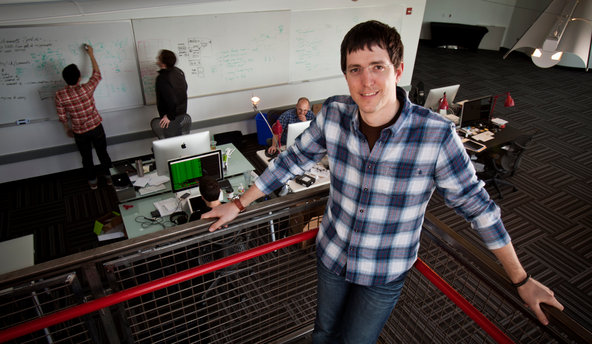 Peter DaSilva for The New York TimesDave Morin, the founder of Path, in the company’s San Francisco offices.
Peter DaSilva for The New York TimesDave Morin, the founder of Path, in the company’s San Francisco offices.
On a recent Thursday night I stood motionless and perplexed on the dance floor of a San Francisco club. As I looked around, 300 or so people danced and darted back and forth to a free open bar while laser lights shot overhead. Cellphones glowed, like a video of luminescent jellyfish, as people snapped pictures and slung moments of the evening onto dozens of social networks.
What made the evening so perplexing was that the party I was attending celebrated Path, a mobile social network that just two months earlier was essentially written off in Silicon Valley. If the company held a party back then, people would have assumed it was a going-out-of-business sale. Now, after rebooting to positive reviews from the blogosphere, Path is again the talk of Silicon Valley. Some are even proclaiming that the company could be “the next Facebook.”
Watching the Valley’s perception of Path go from positive to negative and back has been like watching a hyperactive child with a yo-yo. The valuation has oscillated in near synchronicity.
This, I have learned, is the mentality of much of Silicon Valley, where decisions are not always made based on revenue or potential business models, but instead seem to be driven by a herd mentality and a yearning to be a part of a potential next big thing.
This is most evident in the valuations that are given to companies here. Two start-ups, each with 10 million users and no revenue, can be valued anywhere from $50 million to $1 billion.
Facebook is a prime example of this. The company does generate considerable revenue and is currently valued at $84 billion and is expected to reach $100 billion by the time of its initial public offering later this year. That’s a higher market valuation than Disney or Amazon.
Paul Kedrosky, an investor and entrepreneur, explained in an interview that one reason valuations are so wildly inflated is that venture capitalists want to be associated with a potentially successful start-up just so it looks good in their portfolio. This, he said, has driven absurd buying on the secondary private market, where stocks are bought and sold before a company goes public.
“There is massive buying on the secondary market by venture guys just for the showmanship of it,” he said. “These buyers are much less price sensitive and just want a company in their portfolio so they can stick the logo on their Web site.”
A report released last week by SecondMarket.com, such an online marketplace, said it had $558 million in transactions in 2011, up 55 percent from the year earlier. Almost two-thirds of those transactions were for consumer Web sites and social media start-ups.
Other investors give money to several companies hoping to strike it rich with at least one. I call that the Peter Thiel Effect. Mr. Thiel, a co-founder of PayPal, gave $100,000 to Mark Zuckerberg, a founder of Facebook, when the company was starting out. That investment is expected to be worth $1 billion when Facebook goes public.
In other instances, you have spite investing. This is when venture capitalists will give millions of dollars to a start-up simply because they were not given the opportunity to invest in the competitor with the original idea.
Some investors no longer even need to hear about a company to hand out money. Jakob Lodwick, an entrepreneur and co-founder of Vimeo, recently raised $2 million simply on the promise that he might have a good idea for a company in the near future.
It’s as if someone found out where Hasbro prints Monopoly money and gave every venture capitalist a key to the company’s storage facility.
“I have never seen such a generation of people shorting tech stocks,” Mr. Kedrosky said, noting that he too has chosen to bet that Groupon, Zynga and LinkedIn will fall significantly in value. “Usually the short community is more nervous about it, but there is a monolithic view that this generation of technology I.P.O.’s is completely broken.”
Article source: http://feeds.nytimes.com/click.phdo?i=772c5e74ba4242e61030b343cba93d1a